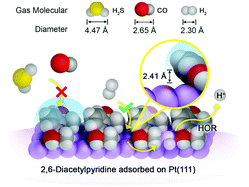当前位置:
X-MOL 学术
›
Energy Environ. Sci.
›
论文详情
Our official English website, www.x-mol.net, welcomes your
feedback! (Note: you will need to create a separate account there.)
Constructing canopy-shaped molecular architectures to create local Pt surface sites with high tolerance to H2S and CO for hydrogen electrooxidation†
Energy & Environmental Science ( IF 32.4 ) Pub Date : 2017-11-30 00:00:00 , DOI: 10.1039/c7ee02641b Tao Wang 1, 2, 3, 4, 5 , Zhi-Xin Chen 1, 2, 3, 4, 5 , Song Yu 1, 2, 3, 4, 5 , Tian Sheng 6, 7, 8, 9 , Hai-Bin Ma 1, 2, 3, 4, 5 , Lu-Ning Chen 1, 2, 3, 4, 5 , Muhammad Rauf 1, 2, 3, 4, 5 , Hai-Ping Xia 1, 2, 3, 4, 5 , Zhi-You Zhou 1, 2, 3, 4, 5 , Shi-Gang Sun 1, 2, 3, 4, 5
Energy & Environmental Science ( IF 32.4 ) Pub Date : 2017-11-30 00:00:00 , DOI: 10.1039/c7ee02641b Tao Wang 1, 2, 3, 4, 5 , Zhi-Xin Chen 1, 2, 3, 4, 5 , Song Yu 1, 2, 3, 4, 5 , Tian Sheng 6, 7, 8, 9 , Hai-Bin Ma 1, 2, 3, 4, 5 , Lu-Ning Chen 1, 2, 3, 4, 5 , Muhammad Rauf 1, 2, 3, 4, 5 , Hai-Ping Xia 1, 2, 3, 4, 5 , Zhi-You Zhou 1, 2, 3, 4, 5 , Shi-Gang Sun 1, 2, 3, 4, 5
Affiliation

|
Rational design and construction of the local environment of active sites on noble metal surfaces is a promising, but challenging, approach for developing high-selectivity catalysts. This study presents an effective approach, via engineering local active sites, aiming to solve the critical problem of H2S and CO poisoning of Pt catalysts for H2 electrooxidation, the anode reaction of polymer electrolyte membrane fuel cells. A canopy-shaped molecular architecture was constructed by immobilizing an organic molecule, 2,6-diacetylpyridine (DAcPy), on Pt surface, which exhibits high H2S (1 ppm) and CO (100 ppm) tolerance. Through electrochemical, spectroscopic, and DFT studies, as well as comparative investigation of analogous structure molecules, it was revealed that DAcPy can be strongly adsorbed on Pt surface through tridentate coordination (two Pt–C and one Pt–N bonds), allowing it to compete with CO and H2S adsorption. The pyridine ring of DAcPy is in a tilted orientation, providing some protection underneath the ring for Pt atoms. Such a height-limited space is just accessible for small-sized H2, but not for relatively large H2S and CO. This study demonstrates that regulating steric hindrance to protect active sites is a promising approach for designing highly selective electrocatalysts.
中文翻译:

构建冠状的分子结构以创建对H 2 S和CO具有高度耐受性的局部Pt表面位点,以进行氢电氧化†
贵金属表面活性位的局部环境的合理设计和构建是开发高选择性催化剂的一种有希望但有挑战性的方法。这项研究提出了一种通过设计局部活性位点的有效方法,旨在解决Pt催化剂的H 2 S和CO中毒对于H 2电氧化(聚合物电解质膜燃料电池的阳极反应)的关键问题。通过将有机分子2,6-二乙酰基吡啶(DAcPy)固定在表现出高H 2的Pt表面上,构建冠状分子结构S(1 ppm)和CO(100 ppm)公差。通过电化学,光谱和DFT研究以及类似结构分子的比较研究,发现DAcPy可通过三齿配位(两个Pt–C和一个Pt–N键)强烈吸附在Pt表面。与CO和H 2 S吸附竞争。DAcPy的吡啶环处于倾斜方向,为该环下方的Pt原子提供了一些保护。这样的高度限制的空间仅适用于小尺寸的H 2,而不适用于相对较大的H 2 S和CO。这项研究表明,调节空间位阻以保护活性位点是设计高选择性电催化剂的一种有前途的方法。
更新日期:2017-11-30
中文翻译:

构建冠状的分子结构以创建对H 2 S和CO具有高度耐受性的局部Pt表面位点,以进行氢电氧化†
贵金属表面活性位的局部环境的合理设计和构建是开发高选择性催化剂的一种有希望但有挑战性的方法。这项研究提出了一种通过设计局部活性位点的有效方法,旨在解决Pt催化剂的H 2 S和CO中毒对于H 2电氧化(聚合物电解质膜燃料电池的阳极反应)的关键问题。通过将有机分子2,6-二乙酰基吡啶(DAcPy)固定在表现出高H 2的Pt表面上,构建冠状分子结构S(1 ppm)和CO(100 ppm)公差。通过电化学,光谱和DFT研究以及类似结构分子的比较研究,发现DAcPy可通过三齿配位(两个Pt–C和一个Pt–N键)强烈吸附在Pt表面。与CO和H 2 S吸附竞争。DAcPy的吡啶环处于倾斜方向,为该环下方的Pt原子提供了一些保护。这样的高度限制的空间仅适用于小尺寸的H 2,而不适用于相对较大的H 2 S和CO。这项研究表明,调节空间位阻以保护活性位点是设计高选择性电催化剂的一种有前途的方法。











































 京公网安备 11010802027423号
京公网安备 11010802027423号